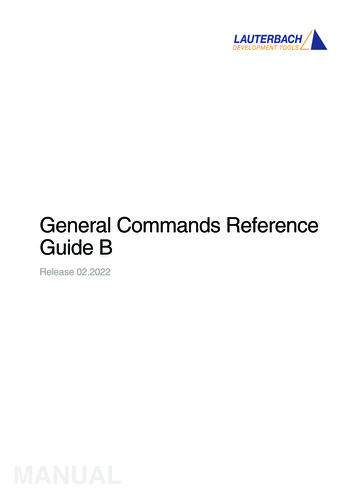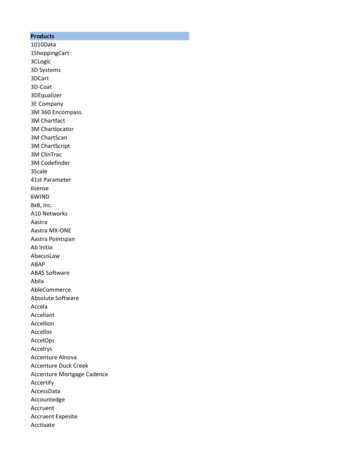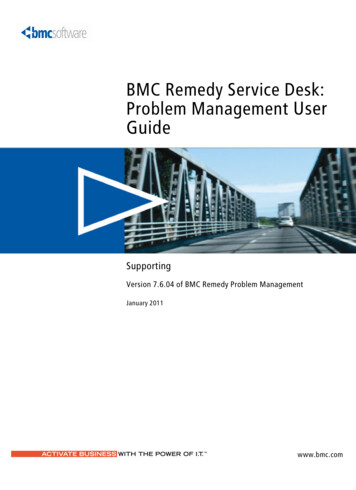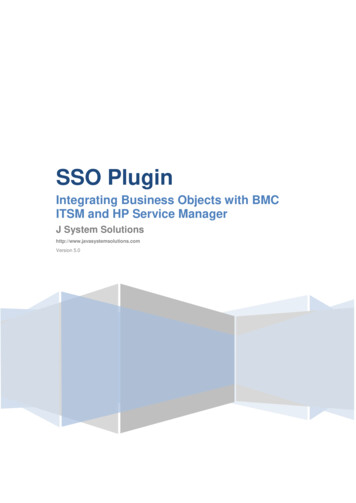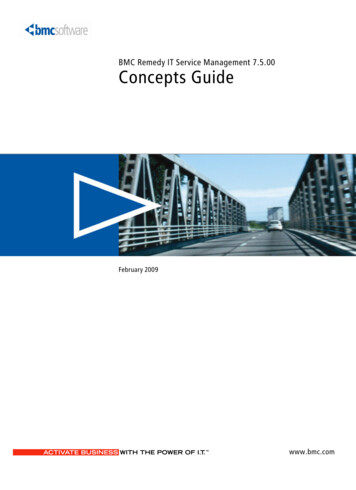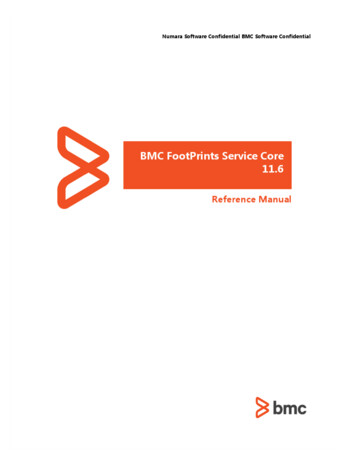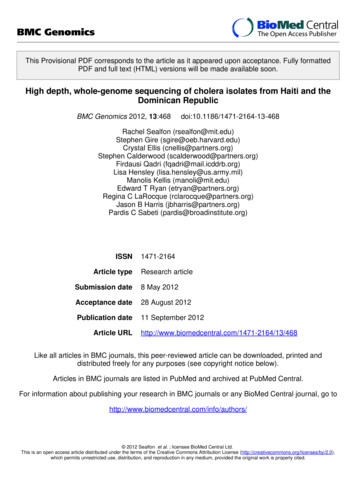
Transcription
BMC GenomicsThis Provisional PDF corresponds to the article as it appeared upon acceptance. Fully formattedPDF and full text (HTML) versions will be made available soon.High depth, whole-genome sequencing of cholera isolates from Haiti and theDominican RepublicBMC Genomics 2012, 13:468doi:10.1186/1471-2164-13-468Rachel Sealfon (rsealfon@mit.edu)Stephen Gire (sgire@oeb.harvard.edu)Crystal Ellis (cnellis@partners.org)Stephen Calderwood (scalderwood@partners.org)Firdausi Qadri (fqadri@mail.icddrb.org)Lisa Hensley (lisa.hensley@us.army.mil)Manolis Kellis (manoli@mit.edu)Edward T Ryan (etryan@partners.org)Regina C LaRocque (rclarocque@partners.org)Jason B Harris (jbharris@partners.org)Pardis C Sabeti (pardis@broadinstitute.org)ISSNArticle type1471-2164Research articleSubmission date8 May 2012Acceptance date28 August 2012Publication date11 September 2012Article ke all articles in BMC journals, this peer-reviewed article can be downloaded, printed anddistributed freely for any purposes (see copyright notice below).Articles in BMC journals are listed in PubMed and archived at PubMed Central.For information about publishing your research in BMC journals or any BioMed Central journal, go tohttp://www.biomedcentral.com/info/authors/ 2012 Sealfon et al. ; licensee BioMed Central Ltd.This is an open access article distributed under the terms of the Creative Commons Attribution License (http://creativecommons.org/licenses/by/2.0),which permits unrestricted use, distribution, and reproduction in any medium, provided the original work is properly cited.
Form ApprovedOMB No. 0704-0188Report Documentation PagePublic reporting burden for the collection of information is estimated to average 1 hour per response, including the time for reviewing instructions, searching existing data sources, gathering andmaintaining the data needed, and completing and reviewing the collection of information. Send comments regarding this burden estimate or any other aspect of this collection of information,including suggestions for reducing this burden, to Washington Headquarters Services, Directorate for Information Operations and Reports, 1215 Jefferson Davis Highway, Suite 1204, ArlingtonVA 22202-4302. Respondents should be aware that notwithstanding any other provision of law, no person shall be subject to a penalty for failing to comply with a collection of information if itdoes not display a currently valid OMB control number.1. REPORT DATE3. DATES COVERED2. REPORT TYPE11 SEP 201200-00-2012 to 00-00-20124. TITLE AND SUBTITLE5a. CONTRACT NUMBERHigh depth, whole-genome sequencing of cholera isolates from Haiti andthe Dominican Republic5b. GRANT NUMBER5c. PROGRAM ELEMENT NUMBER6. AUTHOR(S)5d. PROJECT NUMBER5e. TASK NUMBER5f. WORK UNIT NUMBER7. PERFORMING ORGANIZATION NAME(S) AND ADDRESS(ES)8. PERFORMING ORGANIZATIONREPORT NUMBERUnited States Army Institute of Infectious Disease,FortDetrick,MD,217029. SPONSORING/MONITORING AGENCY NAME(S) AND ADDRESS(ES)10. SPONSOR/MONITOR’S ACRONYM(S)11. SPONSOR/MONITOR’S REPORTNUMBER(S)12. DISTRIBUTION/AVAILABILITY STATEMENTApproved for public release; distribution unlimited13. SUPPLEMENTARY NOTESBioMed Central Genomics 2012, 13:468, Publication date 11 September 201214. ABSTRACTWhole-genome sequencing is an important tool for understanding microbial evolution and identifying theemergence of functionally important variants over the course of epidemics. In October 2010, a severecholera epidemic began in Haiti, with additional cases identified in the neighboring Dominican Republic.We used whole-genome approaches to sequence four Vibrio cholerae isolates from Haiti and theDominican Republic and three additional V. cholerae isolates to a high depth of coverage ( 2000x); four ofthe seven isolates were previously sequenced.15. SUBJECT TERMS16. SECURITY CLASSIFICATION OF:a. REPORTb. ABSTRACTc. THIS PAGEunclassifiedunclassifiedunclassified17. LIMITATION OFABSTRACT18. NUMBEROF PAGESSame asReport (SAR)2519a. NAME OFRESPONSIBLE PERSONStandard Form 298 (Rev. 8-98)Prescribed by ANSI Std Z39-18
High depth, whole-genome sequencing of choleraisolates from Haiti and the Dominican RepublicRachel Sealfon1,2,*Email: rsealfon@mit.eduStephen Gire2,3Email: sgire@oeb.harvard.eduCrystal Ellis4,5Email: cnellis@partners.orgStephen Calderwood4,5Email: scalderwood@partners.orgFirdausi Qadri6Email: fqadri@mail.icddrb.orgLisa Hensley7Email: lisa.hensley@us.army.milManolis Kellis1,2Email: manoli@mit.eduEdward T Ryan4,5,8Email: etryan@partners.orgRegina C LaRocque4,5Email: rclarocque@partners.orgJason B Harris4,9†Email: jbharris@partners.orgPardis C Sabeti2,3,8,*†Email: pardis@broadinstitute.org1Computer Science and Artificial Intelligence Laboratory (CSAIL),Massachusetts Institute of Technology (MIT), Cambridge, MA, USA2Broad Institute of MIT and Harvard, Cambridge, MA, USA3Center for Systems Biology, Department of Organismic and EvolutionaryBiology, Harvard University, Cambridge, MA, USA4Division of Infectious Diseases, Massachusetts General Hospital, Boston, MA,USA5Department of Medicine, Harvard Medical School, Boston, MA, USA
6International Centre for Diarrheal Disease Research, Dhaka, Bangladesh7Viral Therapeutics, United States Army Institute of Infectious Disease, FortDetrick, MD, USA8Department of Immunology and Infectious Diseases, Harvard School of PublicHealth, Cambridge, MA, USA9Department of Pediatrics, Harvard Medical School, Boston, MA, USA*Corresponding author. Broad Institute of MIT and Harvard, Cambridge, MA,USA**Corresponding author. Department of Immunology and Infectious Diseases,Harvard School of Public Health, Cambridge, MA, USA†Equal contributors.AbstractBackgroundWhole-genome sequencing is an important tool for understanding microbial evolution andidentifying the emergence of functionally important variants over the course of epidemics. InOctober 2010, a severe cholera epidemic began in Haiti, with additional cases identified inthe neighboring Dominican Republic. We used whole-genome approaches to sequence fourVibrio cholerae isolates from Haiti and the Dominican Republic and three additional V.cholerae isolates to a high depth of coverage ( 2000x); four of the seven isolates werepreviously sequenced.ResultsUsing these sequence data, we examined the effect of depth of coverage and sequencingplatform on genome assembly and identification of sequence variants. We found that 50xcoverage is sufficient to construct a whole-genome assembly and to accurately call mostvariants from 100 base pair paired-end sequencing reads. Phylogenetic analysis between thenewly sequenced and thirty-three previously sequenced V. cholerae isolates indicates that theHaitian and Dominican Republic isolates are closest to strains from South Asia. The Haitianand Dominican Republic isolates form a tight cluster, with only four variants unique toindividual isolates. These variants are located in the CTX region, the SXT region, and thecore genome. Of the 126 mutations identified that separate the Haiti-Dominican Republiccluster from the V. cholerae reference strain (N16961), 73 are non-synonymous changes, anda number of these changes cluster in specific genes and pathways.ConclusionsSequence variant analyses of V. cholerae isolates, including multiple isolates from theHaitian outbreak, identify coverage-specific and technology-specific effects on variant
detection, and provide insight into genomic change and functional evolution during anepidemic.KeywordsWhole-genome sequencing, Vibrio cholerae, Haitian cholera epidemic, Microbial evolutionBackgroundFollowing the 2010 earthquake in Haiti, a cholera outbreak began in Haiti’s ArtiboniteDepartment and rapidly spread across the country. As of March 18, 2012, a total of 531,683cholera cases have been reported in Haiti, with 7056 deaths due to the epidemic(http://www.mspp.gouv.ht). Cholera cases were also reported in the Dominican Republic[1,2], and cases linked to the outbreak strain have been documented in travelers returning totheir home countries from both Haiti and the Dominican Republic [1,3].The absence of a previously recorded history of epidemic cholera in Haiti [4] raised interestin understanding the source of this outbreak. In order to further characterize the Haitiancholera strain, initial studies applied pulsed field gel electrophoresis and variable numbertandem repeat typing to a large number of microbial isolates from the Haitian choleraoutbreak [5,6]. These analyses identified the Haitian cholera strain as V. cholerae O1 El Tor,placing it as a seventh pandemic strain. In general, these studies found low levels of geneticvariation in isolates, supporting a point-source origin for the outbreak [5-7].More than a year has elapsed since V. cholerae was first introduced into Haiti. Identifyingnovel microbial variants that have emerged over the course of the outbreak may provideinsight into the organism’s evolution on a short time scale. Genomic sequencing is the mostpowerful approach for evaluating such microbial evolution. Next-generation sequencingtechnologies, including Illumina, PacBio, and 454 sequencing, have increased the speed anddecreased the cost of genome-wide sequencing. Chin et al. sequenced two V. choleraeisolates from Haiti using PacBio sequencing, which produces longer reads but has a highererror rate than other next-generation approaches [8]. Reimer et al. used single-end Illuminabased sequencing to sequence eight V. cholerae isolates from Haiti and one from theDominican Republic [9]. Hendriksen et al. compared Haitian V. cholerae sequences tosequences from Nepal, finding that the Haitian isolates are highly similar to a set of isolatescollected in Nepal in the summer of 2010 [10]. These sequencing studies indicated that theHaitian epidemic is most closely related to seventh pandemic strains from South Asia, andthat the Dominican Republic outbreak strain is genetically nearly identical to the Haitianoutbreak strain. The recent study of Hasan et al. [11] identified non-O1/O139 V. choleraestrains in patients in Haiti, and additional work is needed to explore the potential contributionof such strains to disease in Haiti.In this study, we used paired-end Illumina sequencing at a high depth of coverage tosequence one V. cholerae isolate from the Dominican Republic, three isolates from Haiti, andthree additional V. cholerae isolates. Four of the isolates were previously sequenced using avariety of sequencing technologies [8,12,13], and we present a comparison between sequencedata generated using Sanger-based, next-generation, and PacBio sequencing technologies.The sequenced isolates include a classical O1-serogroup isolate from the sixth pandemic andan O139-serogroup strain as well as O1 El Tor strains from the seventh pandemic. The
diverse strains sequenced and the high depth of coverage allow us to probe the sequencecoverage required for optimal assembly and variant calling of the V. cholerae genome usingnext generation sequencing. Our data characterize the depth of coverage needed to accuratelyresolve sequence variation between V. cholerae strains.We further identify sequence differences between the Haitian and Dominican Republicisolates in comparison to previously published and newly sequenced worldwide samples, andin comparison to each other. The three isolates from Haiti were collected in the same hospitalin the Artibonite Department in October, 2010. The Dominican Republic isolate wascollected three months later, in connection with a cholera outbreak among guests returningfrom a wedding in the Dominican Republic [1]. Since epidemic cholera had not been reportedin Hispaniola prior to 2010, examining microbial mutations as the outbreak spread from Haitito the Dominican Republic three months later provides insight into the temporal evolution ofepidemic V. cholerae.Results and discussionSequencing seven V. cholerae isolates at high depth of coverageWe sequenced seven V. cholerae isolates, including three isolates from Haiti (H1*, H2* andH3), one from the Dominican Republic (DR1), two from Bangladesh (N16961* andDB 2002), and one from India (O395*). Four of these isolates (H1*, H2*, N16961*, andO395*) were previously sequenced using a variety of sequencing technologies and to varyingdepths, and are denoted with an asterisk. We sequenced all strains to high depths of coverage(2643 – 5631x; Additional file 1: Table S1). We have deposited the sequence data in theSequence Read Archive database (Submission: SRA056415).Effect of depth of coverage on genome assembly and single-nucleotidepolymorphism (SNP) callingThe high depth of coverage of our sequencing enabled comparison of the efficacy of de novoassembly and variant detection at multiple depths of coverage. To assess the assemblyquality, we used the N50 statistic. N50, a common metric of assembly quality, is the numberof base pairs in the longest contig C such that fewer than half of the base pairs in the genomelie in contigs that are longer than C. We selected a random sample of the total reads for eachisolate and compared the median N50 value for assemblies produced by Velvet at a range ofcoverage depths (5x to 250x), with three random read samples at each depth of coverage. Formost isolates, N50 is stable across the range of depths from 50x to 250x, suggesting that 50xcoverage is sufficient to construct a de novo assembly for these samples (Figure 1A).However, N50 continues to increase up to 100x coverage in sample H1*. The average readquality in H1* is the lowest of all the samples (Additional file 2: Table S2), suggesting thatwhile 50x is sufficient depth of coverage for de novo genome assembly on most samples,greater coverage is needed when average base quality is low.Figure 1 Fiftyfold coverage suffices for whole-genome assembly and detection of mostsequence varients. (A) The N50 of the assembly, shown over a range of coverage depths(5x-250x), rapidly increases up to 50x coverage, and then plateaus. The median N50 ofassemblies of five disjoint sets of reads at each depth of coverage is shown. (B) The numberof SNPs detected increases rapidly up to 50x coverage, and gradually thereafter. (C) The
number of insertions and deletions detected increases rapidly up to 20x coverage, andplateaus after 50x coverage. SNPs, insertions, and deletions in all isolates except for O395*are called relative to the N16961 genome [GenBank:AE003852, GenBank:AE003853]. Forthe O395* sample, due to the large number of differences ( 20,000 SNPs) from the N16961reference, SNPs, insertions, and deletions were identified instead against the Sangersequenced O395 reference [GenBank:CP000626, GenBank:CP000627]We explored the effect of depth of coverage on calling sequence variants by examining theSNPs, insertions, and deletions identified at a range of coverage depths (5x to 250x). For allisolates, the number of SNPs identified increases sharply up to 50x coverage, and continuesto increase gradually after this point (Figure 1B). In six of the seven isolates, at least 85% ofthe SNPs identified at 250x coverage are also identified at 50x coverage (the exception wasthe O395 sample, since at 50x coverage, we did not detect one of the three SNPs found at250x coverage). SNPs identified uniquely at higher depths of coverage include variants inregions where the average base quality is low, regions with unusually low depths of coveragecompared to the rest of the genome, and regions with false positive calls due to misalignmentof reads across a deletion. Fifty-fold coverage is also sufficient to identify nearly all of theinsertions and deletions observed at higher depths of coverage (Figure 1C). At 50x coverage,we detected at least 98% of the insertions and deletions observed at 250x coverage in eachisolate. Twenty-fold coverage is sufficient to detect the majority of insertions and deletions;at least 90% of insertions and deletions that are observed at 250x coverage are also found at20x coverage in five of the seven isolates. These results suggest that 50x coverage issufficient to accurately call most variants, although deeper coverage provides additionalpower for identifying SNPs in some genomic regions.Comparison of sequence variants, insertions, and deletions identified usingmultiple sequencing approachesFour of our isolates were previously sequenced using a variety of platforms. Thosesequencing results provide an opportunity for us to compare variant calls across sequencingtechnologies, validate variant calls, and identify potential errors in reference sequences.Comparison to N16961 Sanger reference sequencesThe original reference genome for V. cholerae was the Sanger-sequenced N16961 genome[12]. Feng et al. subsequently identified a number of corrections to the reference based oncomparisons to additional strains at ambiguous positions and open reading frame clonesequence data [13]. Their corrections included 58 single base pair differences and 63insertions and deletions. Similarly, we identified 59 single base pair differences as well as 95insertions and deletions between N16961* and the N16961 reference [12] (Figure 2B).Figure 2 Comparison of SNPs, insertions, and deletions called across sequencingtechnologies. (A) List of published sequences for the four previously sequenced isolates(N16961, O395, H1, and H2) examined in this study. (B) Comparison of new Illuminasequences to GenBank references. The number of differences identified in the new sequencerelative to the GenBank reference is shown in the table, with the number of differencesconfirmed by alignment to additional strains shown in parentheses. (C) Comparison ofIllumina-based and PacBio-based SNP, insertion, and deletion calls relative to the Sangersequenced N16961 reference [GenBank:AE003852, GenBank:AE003853]. The number of
variants called in PacBio sequencing only (red circle), in Illumina sequencing only (bluecircle), or in both (intersection) are shown. For the N16961 sequences, the number ofdifferences confirmed by alignment to additional strains is shown in parentheses. For H1 andH2, only variants that do not correspond to likely errors in the N16961 reference sequence arecountedTo validate variant calls where the N16961* sequence differs from the correspondingreference, we examined the positions corresponding to those differences, using the MicrobialGenome Browser alignment. Positions that differ between the reference sequence and thenew isolates may represent errors in the reference sequence, false positive SNP calls, ormutations introduced during lab passage of the strains. If the discrepancy is due to an error inthe reference sequence, then the sequences of additional strains in the alignment (O395 andMO10 for the N16961 sequence, N16961 and MO10 for the O395 sequence) are likely toagree with our variant call and disagree with the reference (Additional file 3: Table S3). For54 of the 59 differences, the alignments to strains O395 and MO10 support our new calls inN16961* (Additional file 3: S3). Alignment to the additional strains supports all but one ofthe 95 insertions and deletions identified between N16961 and N16961*, consistent with theinterpretation that the discordant positions correspond to errors in the reference sequence. Wecombined the corrections to the N16961 reference sequence previously identified by Feng etal. [13] with the validated variants that we identified to generate an updated list of sequencecorrections (Additional file 4: Table S4).Comparison to O395 Sanger and O395 ABI/454 sequencesTo identify positions at which the sequence differed across multiple technologies, wecompared the O395* sequence to the O395 Sanger and ABI/454-sequenced GenBank:CP001235,GenBank:CP001236], respectively). We detected 3 SNPs between the O395* isolate and theSanger-sequenced reference. BLAST queries indicated that in closely related strains, thesequence matches the reference at the position of these SNPs. However, manual examinationof the SNP positions indicated that they are likely to be real variants, suggesting that theymay have been introduced during laboratory passage of the O395 isolate (Additional file 5:Table S5). We did not detect any insertions or deletions between the O395* sample and theO395 Sanger-sequenced reference. Between the O395* sequence and the ABI/454-sequencedO395 reference (Figure 2B), we detected seven additional single-base pair differences, fourdeletions, and one insertion. The accuracy of our Illumina calls at nine of these twelvepositions is supported by their agreement with the Sanger-sequenced reference; for the otherthree positions, the Sanger-sequenced reference agrees with the ABI/454 calls.Comparison to PacBio sequencesWe compared three of the isolates that we sequenced (N16961*, H1*, and H2*) to previouslypublished PacBio sequences for these same isolates (Figure 2C) [8]. In the N16961* sample,83% of the SNPs that we identified (49/59 differences) were also present in the PacBio-basedSNP calls. We identified ten SNPs not found in the PacBio variant calls, seven of which arevalidated by alignment to additional strains. Chin et al. reported five SNPs that we did notdetect. Four of the five variants identified uniquely in the PacBio-based calls lie in repetitiveregions of the genome, and these calls are supported by alignment to additional strains. Theremaining SNP is not supported by alignment to additional strains. Although the majority ofsingle nucleotide variant calls were consistent across platforms, only 55% of our Illumina-
based insertions and deletions were also found using PacBio sequencing (52/95 indels). Weidentified 43 insertions and deletions in the N16961* sample not identified in the PacBiosequencing, and Chin et al. reported seven insertions and deletions that we did not recover.Only one of the seven insertions and deletions unique to the PacBio sequence is supported byalignment to additional strains, suggesting that the Illumina-based sequencing of the N16961strain provided more sensitive and specific detection of insertions and deletions than thePacBio-based sequencing.We also compared the variants identified in the H1 and H2 isolates relative to the N16961reference by PacBio sequencing (H1, H2) with those identified by Illumina sequencing (H1*,H2*) (Figure 2C). Ninety-five percent (121/128) of the SNPs we identified in H1* wereidentified in the PacBio sequencing as well, while 83% (111/133) of the SNPs we called inH2* were also called in the PacBio sequencing. Thirty-one SNPs were identified uniquely inthe PacBio sequencing of H1, while 28 SNPs were identified uniquely in the PacBiosequencing of H2. Many of the variant calls (11 in H1, 12 in H2) that were identified only byPacBio sequencing lie in repeat regions of the genome, suggesting that the long PacBio readsmay facilitate detection of SNPs in repetitive regions of the genome that are difficult torecover using the shorter Illumina reads. Of the insertions and deletions that we identified inH1* and H2*, only 20-30% (3/9 for H1, 2/10 for H2) were also recovered in the PacBiobased calls. The PacBio-based sequencing identified 16 insertions and deletions in H1 and 18in H2 not found in the Illumina-based calls. Thus, while both the Illumina-based and thePacBio-based sequencing identified similar SNPs, the insertion and deletion calls were highlydivergent between the two approaches.Identifying SNPs, insertions, deletions, and structural variation across isolatesAnalysis of an O139 serogroup isolate from BangladeshThe O139 serogroup isolate from Bangladesh (DB 2002) was collected in Dhaka in 2002 andhas not been previously sequenced. Relative to the N16961 reference strain, the isolate hasdeletions in the VPI-II genomic island, the superintegron, and a region on chromosome 1associated with O antigen synthesis which contains genes involved in lipopolysaccharide andsugar synthesis/modification. The DB 2002 isolate contains two long regions that are absentfrom the N16961 reference. A 35,000-base pair region in the assembly of DB 2002 matchesa region in an O139-serogroup strain from southern India that encodes genes for O-antigensynthesis [GenBank:AB012956.1]. The DB 2002 assembly also contains an 84,000-base pairregion matching SXT integrative and conjugative element sequences in GenBank.The genomic content of the DB 2002 isolate is similar to that of other O139 serogroupisolates. Phylogenetic analysis indicates that DB 2002 clusters closely with an O139serogroup isolate from India (MO10, [GenBank: AAKF03000000]) (Figure 3). The deletionsin the superintegron, absence of the VPI-2 genomic island, presence of the SXT region, anddifferences in O antigen genes are characteristic of other O139-serogroup isolates [14,15].Figure 3 Phylogeny of the sequenced strains and 33 previously sequenced V. choleraeisolates. We constructed a maximum-likelihood phylogeny using RaxML based on genesconserved across all newly sequenced isolates as well as 33 previously sequenced V. choleraeisolates. The isolates sequenced in our study are shown in red
Analysis of Dominican Republic and Haitian isolatesThe Haitian and Dominican Republic isolates cluster closely together and group in thephylogenetic tree with other seventh pandemic strains (Figure 3). Among the isolates in ourphylogeny, the Haitian and Dominican Republic strains cluster most closely with strains fromBangladesh (CIRS101, [GenBank: ACVW00000000] and MJ-1236, [GenBank:CP001485,GenBank:CP001486]). In the alignments used to construct the phylogeny, there are anaverage of 12 substitutions between the newly sequenced Haitian/Dominican Republicisolates and CIRS101, and an average of 46 substitutions between the Haitian/DominicanRepublic isolates and MJ-1236.To further characterize the Haitian and Dominican Republic isolates, we identified deletionsand copy number variation relative to reference sequences (Figure 4). In all Haitian andDominican Republic isolates, deletions were observed in the VSP-2 and superintegronregions. There are also deletions in the SXT region of the Haitian and Dominican Republicisolates relative to the MJ-1236 reference strain from Bangladesh (Additional file 6: TableS6). To identify novel insertions, we aligned a 150x-coverage sample of N16961* reads tothe de novo assembly of each Dominican Republic and Haitian isolate. All 1000-base pairwindows in the de novo assemblies of the Haitian and Dominican Republic isolates to whichN16961* reads did not map matched SXT integrating conjugative element sequences inGenBank, suggesting that no additional large insertions are present in the genomes of theseisolates.Figure 4 Variation in depth of coverage of the sequenced isolates, based on readalignments of the seven sequenced strains against the N16961 reference genome.Chromosome 1 (A) and chromosome 2 (B) are shown. The depth of coverage of 1000 basepair windows of 150x average coverage subsamples of the DR1 (outermost circle), H1*, H2*,H3, N16961*, O395*, and DB 2002 (innermost circle) isolates is displayed. Regions at lowdepth of coverage ( 12x) are shown in red, while regions at high depth of coverage ( 240x)are shown in blue. The depth of coverage in each window is displayed using the Circos tool[34]. Genomic islands as defined in [15] and the superintegron region as defined in [8] areshownThe four isolates from Haiti and the Dominican Republic are nearly identical in genomicsequence, consistent with a clonal origin for the epidemic. We identified three SNPs betweenthe Haitian and Dominican Republic isolates, as well as one additional mutation in one of theHaitian isolates (Table 1). No sequence differences were identified between isolates H1* andH3, and no large-scale structural variation was observed across the Haitian and DominicanRepublic isolates.Table 1 Unique single nucleotide polymorphisms identified in individual Haitian andDominican Republic cholera strains, in comparison to all other Haitian and DominicanRepublic strainsIsolate Chromosome LocationRefVariant Associated GeneType ofAllele AlleleChangeDR1 11565917/1572833* TCrstAUpstreamof geneH2* 2166022CTTagA-related protein Nonsyn
DR12467913GAPyruvate-flavodoxin Synoxidoreductase†DR1 13055641ACTransposase Tn3Nonsynfamily protein*The two locations provided for the rstA-related mutation correspond to the two copies ofthis gene in the N16961 reference strain.†While all other genomic coordinates in the table are specified with respect to the N16961reference strain, this variant lies in the SXT region, absent from the N16961 reference. Here,the genomic coordinates are specified with respect to the MJ-1236 reference.Functional annotation of variants in Haitian and Dominican Republic cholerastrainsThe four isolates from Haiti and the Dominican Republic (DR1, H1*, H2*, and H3) arenearly identical in genomic sequence and share 126 variants relative to the N16961 reference.Seventy-three of these variants are non-synonymous mutations in coding genes. Notably, anumber of the non-synonymous mutations occur in the same gene, or in genes with similarfunction, potentially indicating adaptive convergence. These include three mutations in thecholera enterotoxin (B subunit), and two mutations in MSHA biogenesis proteins (MshJ andMshE), which are involved in bacterial adhesion [16]. There are also two mutations that lie intwo distinct DNA mismatch repair proteins, and two mutations in two outer membraneproteins, OmpV and OmpH.In order to identify purifying or positive selection between the N16961 reference and theHaitian/Dominican Republic V. cholerae strains, we simulated random mutations in thecholera genome. To simulate random point mutations, we selected a genomic positionuniformly at random, looked up the nucleotide at that position, and then randomly selectedone of the three other possible bases at that position. We set the number of mutations equal tothe nu
SPONSORING/MONITORING AGENCY NAME(S) AND ADDRESS(ES) 10. . Approved for public release; distribution unlimited 13. SUPPLEMENTARY NOTES BioMed Central Genomics 2012, 13:468, Publication date 11 September 2012 14. ABSTRACT Whole-genome sequencing is an important tool for understanding microbial evolution and identifying the emergence of .
